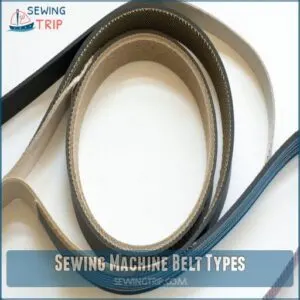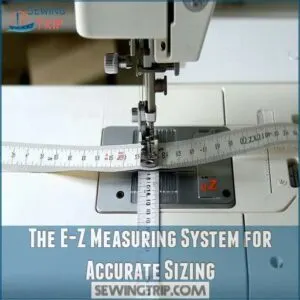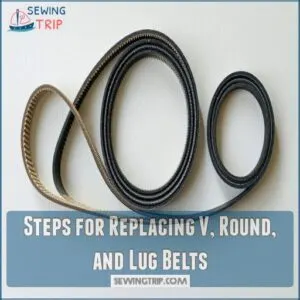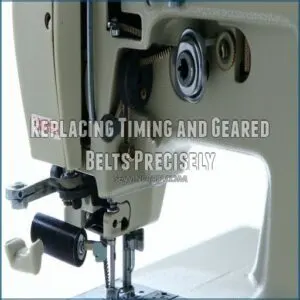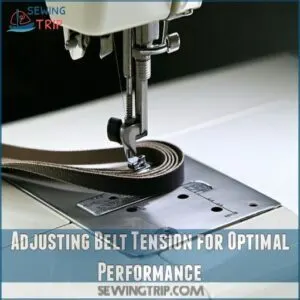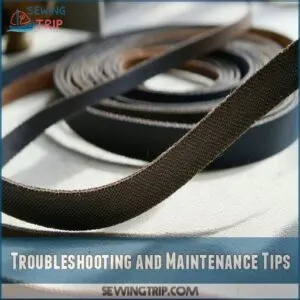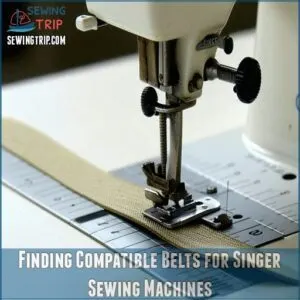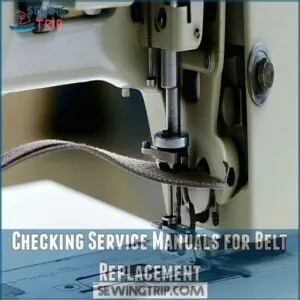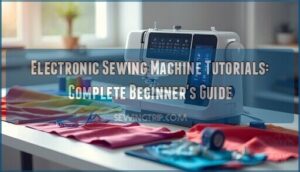This site is supported by our readers. We may earn a commission, at no cost to you, if you purchase through links.
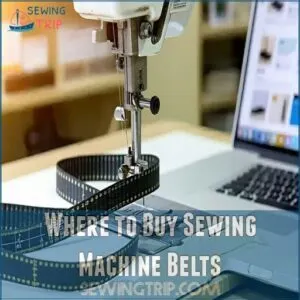
Online retailers like Amazon and specialized sites such as SewingPartsOnline offer a wide selection—just make sure you’ve got your machine’s model number handy.
Before buying, check your service manual to confirm the right belt type: V-belts, stretch belts, or timing belts can vary by machine.
Pro tip: read customer reviews, compare prices, and verify part compatibility to avoid a frustrating mismatch. Your sewing machine will thank you for the TLC.
Table Of Contents
Key Takeaways
- You’ll want to check both local hardware stores and online retailers like Amazon and SewingPartsOnline when buying sewing machine belts, but always have your machine’s exact model number ready.
- Don’t just grab any belt – you’ll need to understand the different types (V-belts, stretch belts, timing belts) and carefully measure your machine’s specific requirements to ensure a perfect fit.
- Before purchasing, you’ll save yourself headaches by reading customer reviews, comparing prices, and verifying part compatibility to avoid buying the wrong belt for your machine.
- You’ll extend your sewing machine’s life by performing regular maintenance, including checking belt condition every few months and replacing belts every 3–5 years or when signs of wear appear.
Sewing Machine Belt Types
Knowing the different types of sewing machine belts is key to keeping your machine running smoothly.
From stretch belts to geared belts, each one has a specific purpose and compatibility to evaluate.
V-Belt Systems and Characteristics
A V-belt system relies on friction to get the job done, making it a dependable choice for sewing machines. It snugly fits into the pulley groove and boasts durability.
- Key materials: Often rubber for flexibility.
- Sizes vary: Measure carefully for a proper fit.
- Long lifespan: With regular maintenance.
- Efficient design: Prevents slipping during use.
Positive Traction Systems and Characteristics
Positive traction systems rely on belt teeth designs that lock into the machine’s pulleys for precision.
They’re durable but demand exact compatibility, so interchangeability issues can arise.
These sewing machine belts tend to cost more and require careful maintenance.
If you’re looking for this type of sewing machine belt replacement, focus on proper sizing to avoid performance hiccups with your sewing machine parts.
Stretch Belts and Lug Belts Comparison
Stretch belts and lug belts each bring their perks to sewing machine belt replacement.
Stretch belts shine with ease of installation and self-adjusting durability, but their performance review highlights occasional slippage.
Lug belts, on the other hand, boast superior traction and reliability, though they demand precise sizing.
Considering cost differences and maintenance needs, both can fit different budgets and skill levels.
Solid Belts and Round Belts Differences
Solid belts offer durability and strong traction levels, making them ideal for older sewing machine models. They’re sturdy, with fewer size variations, but cost differences can lean higher.
Round belts, while flexible and cheaper, struggle with traction and are often a last-resort option.
In the context of sewing machine belt types, application suitability should guide your choice.
Geared Belts and Timing Belts Distinctions
Geared belts and timing belts are essential sewing machine belt types, designed for precision.
Geared belts have teeth that lock perfectly into place, ensuring accurate movement.
Timing belts keep the needle bar and hook synchronized, essential for smooth stitches. Their installation demands exact sizing and alignment to avoid misalignment.
Always consult sewing machine belt replacement parts guides to find the right fit.
Where to Buy Sewing Machine Belts
Knowing the types of sewing machine belts is great, but figuring out where to buy sewing machine belts can feel overwhelming.
Start locally—check hardware shops, sewing machine repair stores, or craft stores. They might’ve belts on hand or can guide you to reliable suppliers. Local suppliers might’ve quicker options, though prices can vary.
Prefer convenience? Browse online retailers like SewingPartsOnline or Amazon, which offer sewing machine belts for sale. Just watch for warranty issues or unclear belt specs. Shopping online also lets you do quick cost comparisons, and some stores even highlight customer reviews to confirm quality.
If you’re unsure, call a professional to double-check compatibility before buying. It’s better than ordering the wrong size!
Measuring and Replacing Sewing Machine Belts
Replacing a sewing machine belt might seem tricky.
but with the right steps, it’s straightforward.
You’ll need accurate measurements and a bit of patience to guarantee your machine runs smoothly.
The E-Z Measuring System for Accurate Sizing
The E-Z measuring system makes sewing machine belt replacement a breeze. Accuracy matters, and here’s how to use it:
- Remove the belt and loop one end over a ruler.
- Pull the belt taut and note the belt’s length in 1/8-inch increments.
- If the belt’s missing, use a non-stretch cord for measuring tips.
- Taking tight measurements will prevent troubleshooting issues later.
Measuring Internal Belts and Geared Belts
Diving into internal belt mysteries, you’ll need a service manual as your trusty roadmap. Accessing internal belts requires precision and patience.
When searching for the correct replacement, consider checking the sewing machine belt sizes to guarantee a proper fit.
Here’s a quick reference guide to help you navigate the process:
| Step | Action | Tool |
|---|---|---|
| 1 | Locate motor access | Service manual |
| 2 | Mark needle bar position | Permanent marker |
| 3 | Identify pulley cog | Flashlight |
| 4 | Remove old belt | Screwdriver |
| 5 | Install new belt | Alignment marks |
Careful alignment prevents timing nightmares and keeps your machine humming smoothly.
Steps for Replacing V, Round, and Lug Belts
Swap out V, round, or lug belts like a pro with these belt installation hacks.
Master your sewing machine belt replacement in four simple steps:
- Loosen the motor screw carefully
- Remove the old belt smoothly
- Install the new belt with precision
- Reset the motor, leaving 1/4" to 1/2" slack
Keep your machine humming with these DIY belt repair tips!
Replacing Timing and Geared Belts Precisely
When replacing timing and geared belts, precision becomes your best friend.
Raise the needle bar to its highest point and mark it carefully.
Mark the top cog on the motor pulley.
Remove the old belt, then install the new one, ensuring perfect alignment with those previous markings.
Double-check your service manual for model-specific nuances.
Adjusting Belt Tension for Optimal Performance
Got motor belt tension woes? A precise sewing machine belt adjustment can be your secret weapon against performance hiccups.
Loosen the motor mounting screw slightly, allowing about 3/16" of slack.
Shift the motor upward gently, ensuring proper slot alignment.
Tighten carefully and test—you’ll avoid tension-related headaches and keep your machine humming like a well-oiled symphony.
Troubleshooting and Maintenance Tips
Don’t let a finicky sewing machine belt derail your crafting project—with the right troubleshooting skills, you’ll quickly diagnose and fix belt problems.
Your sewing machine’s performance depends on catching worn or misaligned belts early, so you’ll want to know exactly what signs to watch for and how to keep your machine running smoothly.
Identifying Faulty External and Internal Belts
Regularly, your sewing machine’s belt whispers tales of its health through subtle signs. Here’s how to decode those mechanical murmurs and catch potential issues before they snowball:
- Listen for unusual clicking or grinding noises
- Check for visible cracks or fraying edges
- Observe inconsistent stitching patterns
- Feel for unusual belt slackness or tension
- Inspect motor pulley alignment during operation
Your machine’s belt is its heartbeat – listen closely.
Signs of Worn-Out or Damaged Belts
After spotting telltale belt wear, you’ll want to act fast.
Belt cracking, fraying edges, or squeaking sounds scream trouble.
Reduced sewing speed and visible damage signal it’s time for sewing machine belt repair.
Check for slack, visible deterioration, or unusual noises that interrupt your smooth stitching rhythm.
Your machine’s performance depends on catching these warning signs early.
Preventing Misalignment and Timing Issues
If belt misalignment throws your sewing machine’s rhythm off-beat, you’ll want to nail the perfect installation.
Precision is key when aligning cogs and adjusting motor positioning.
Double-check your belt’s placement, ensuring it sits snug in the pulley grooves without slack.
A misaligned belt can turn your smooth sewing session into a frustrating wrestling match with your machine.
Regular Maintenance for Longer Belt Life
Just like a well-oiled machine, your sewing buddy needs TLC to keep humming along smoothly. Preventative care is your secret weapon for sewing machine belt maintenance.
Clean your belt regularly with a soft cloth, inspect it monthly for wear, and store your machine in a cool, dry spot.
A little lubrication and careful handling can stretch your belt’s life and keep your stitches perfect.
Additionally, replacing the belt every 3-5 years or when signs of wear appear is essential for peak performance.
Locating Replacement Belts for Specific Sewing Machines
When you’re hunting for the perfect sewing machine belt, you’ll want to know exactly where to look and how to find the right fit.
Your best bet is to start by checking your machine’s service manual.
browsing specialized online marketplaces like www.sewingpartsonline.com, which can help you track down the exact belt your sewing machine needs.
Finding Compatible Belts for Singer Sewing Machines
Singer sewing machine belts can be a treasure hunt for DIY enthusiasts.
You’ll want to crack the code of Singer belt numbers by exploring specialized online marketplaces like sewingpartsonline.com.
Regular maintenance, such as cleaning and greasing, is also vital for peak sewing machine performance.
Pro tip: match your machine’s model precisely to avoid compatibility issues.
Most vintage and modern Singer models have specific belt requirements that can make or break your sewing machine’s performance.
Checking Service Manuals for Belt Replacement
After pinpointing your specific sewing machine model, crack open that service manual like a treasure map.
Manual diagrams reveal installation steps, belt part numbers, and troubleshooting guides specifically designed for your machine.
They’re your secret weapon for sewing machine maintenance, showing exactly how to replace sewing machine belts without playing a guessing game.
Navigating Online Marketplaces for Belt Purchases
Online marketplaces open up a world of possibilities when hunting for sewing machine belts.
Websites like Amazon and eBay let you compare prices, read detailed reviews, and check belt compatibility with your specific model.
You can also find dedicated stores that specialize in sewing machine belts.
Pro tip: verify seller ratings, ask about return policies, and cross-reference part numbers to dodge potential scams and make certain you’re getting the right belt.
Frequently Asked Questions (FAQs)
Where can I buy a new belt for my sewing machine?
Stranded with a broken belt, you’ll find salvation at www.sewingpartsonline.com or Amazon.
Measure carefully, match your machine’s model, and you’ll be stitching again in no time.
hassle-free and budget-friendly.
Why do sewing machines use V-belts?
V-belts grip your sewing machine’s motor pulley like a champ, using friction to transfer power smoothly.
They’re tapered to fit snugly, ensuring your machine runs efficiently.
V-belts and motor’s performance are key to efficient sewing machine operation, preventing slipping or straining.
What type of belt does a sewing machine use?
Sewing machines typically use V-belts, tapered to fit snugly in motor pulleys.
You’ll find stretch, lug, and solid belts depending on your machine’s model and age, each designed for specific traction and performance needs.
How do you install a belt on a sewing machine?
You’ll want to carefully remove the old belt, measure its length precisely, and match the new belt’s type.
Loosen motor screws, slide the fresh belt in place, and adjust tension for smooth, reliable sewing performance.
Where can I buy Singer sewing machine belts?
When your sewing machine belt snaps mid-project, www.sewingpartsonline.com becomes your lifeline.
Navigate to "machine parts", select your Singer model, and choose compatible belts.
that’ll get you stitching again in no time.
Do I need a new timing belt for my sewing machine?
If your machine’s struggling, skipping stitches, or making weird noises, it might need a timing belt. Check for visible wear, misalignment, or irregular needle movement that signals potential belt replacement.
Are all sewing machine belts the same?
Not all sewing machine belts are created equal.
They come in different types like V-belts, lug belts, and stretch belts.
Each machine requires a specific belt type, so don’t assume one size fits all.
How do I know my sewing machine belt size?
Measure your sewing machine belt by removing it and stretching it alongside a ruler.
Mark the length in 1/8" increments.
For tricky spots, use a shoestring and compare to your original belt’s size.
Which belt is used in a sewing machine?
You’ll find four main sewing machine belt types: V-belts, lug belts, round belts, and geared belts.
Each type serves a different purpose, with V-belts and lug belts being the most common for home sewing machines.
Choose wisely to keep your machine running smoothly.
What is the length of a sewing machine belt?
Like a heartstring vibrating with precision, your sewing machine belt’s length varies.
Typically, it ranges from 10 to 17 inches, depending on your machine’s model and pulley system.
Measure carefully for a perfect fit.
Conclusion
Ironically, your sewing machine’s heartbeat – its belt – is often the most overlooked component.
When hunting for where to buy sewing machine belts, you’ve now got a roadmap to success.
Whether you’re browsing local shops or clicking through online retailers, remember that a perfect belt match can resurrect your beloved machine.
Armed with knowledge about types, measurements, and maintenance, you’ll keep your stitching smooth and your creativity flowing. Happy sewing!

